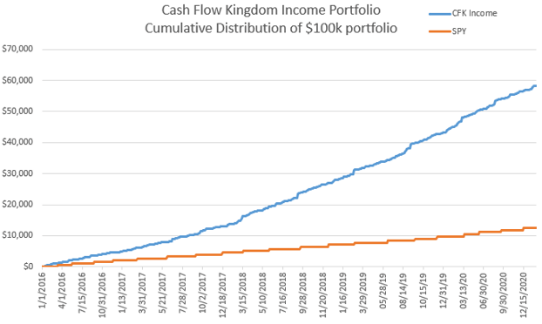Energy Transfer's Dividend: Mission Accomplished
Summary
- Energy Transfer has increased its dividend again, hitting the old pre-crisis level.
- Management has delivered on its promise, which is great.
- Shares are still far from expensive and offer a compelling dividend yield of 9%.
- Looking for more investing ideas like this one? Get them exclusively at Cash Flow Club. Learn More »
bpawesome
Article Thesis
Energy Transfer (NYSE:ET) has increased its dividend again, with the dividend now being back at pre-crisis levels -- the company has achieved its goal of restoring the dividend. Now, investors get a very compelling dividend yield of more than 9% that is well-covered by the company's cash flows. With debt reduction on track as well, ET will be well-positioned to drive further shareholder value in the coming quarters and years, either by increasing the dividend further or by moving towards share repurchases, which would be highly accretive thanks to an inexpensive valuation.
The Dividend Bulls Had It Right
Energy Transfer cut its dividend in half during the initial phase of the pandemic. Many investors didn't like that move, but it was understandable at the time -- there were major uncertainties about the economy's future performance, about ET's counterparty risk due to low oil prices, and last but not least, financial markets were troubled, which could have resulted in problems for a heavily indebted company like Energy Transfer.
But it soon became clear that the lockdowns wouldn't last forever, and that oil and natural gas demand would be recovering soon. ET's business model was way more resilient than feared, and it became clear that Energy Transfer wouldn't be running into major problems. So management started to communicate to shareholders that reinstating the dividend at pre-crisis levels -- $0.305 per share per quarter -- was a priority for the company.
Some bearish investors argued that this wouldn't come true, that the company was too heavily indebted, that ET would go back to its old ways of chasing growth without growing shareholder value, and so on.
However, bullish investors including me argued that the company had changed its ways following the CEO change -- Energy Transfer wouldn't chase growth in the future, but instead put more focus on driving shareholder value by focusing on deleveraging and restoring its dividend. And that is exactly what happened:
The company has increased its dividend for several quarters in a row, and with the dividend increase that was announced on January 26, the company has finally achieved its goal -- following a 15% dividend hike, the payout is now back at the level where it was before the pandemic. For shareholders, that's good due to several reasons, I believe.
First, a dividend increase results in a larger income stream, of course. Income investors will be especially happy to see their dividends rise by another 15% from the previous level, thereby allowing for a faster reinvestment pace, or, alternatively, for more income to live off.
Second, the full dividend restoration proves that management is trustworthy. Despite what some bears said, the company did do exactly what it had stated it would do -- it brought back the dividend to the old level in a timely and efficient manner, putting a clear focus on that goal without wasting resources on other efforts.
Third, the company has now become pretty flexible when it comes to allocating capital. The dividend has been restored, and the company can now decide, based on market circumstances, business progress, and so on, what to do with the massive cash flows the company generates.
The Cash Flow Picture Is Strong
Let's delve a little further into Energy Transfer's cash flows and its capital allocation options going forward.
The company announced its third-quarter earnings results on November 1. At that point, the company increased its guidance for fiscal 2022, raising the EBITDA estimate from $12.7 billion to $12.9 billion. Based on that, we can calculate the company's distributable cash flow, which is operating cash flow minus maintenance capital expenditures. Distributable cash flow, or DCF, is an important metric for energy midstream companies such as Energy Transfer as this tells us what the company has available for debt reduction, dividends, share repurchases, or growth spending via M&A or organic growth projects.
When we start with estimated EBITDA of $12.9 billion and subtract EBITDA that belongs to minority holders in Sunoco (SUN) and USA Compression Partners (USAC) while also subtracting interest expenses and preferred equity distributions, we get to around $9.5 billion. The company originally planned to spend around $2.5 billion on capital expenditures in 2022, for both maintenance and growth projects. It's possible that the actual spending was a little higher than that due to inflation, so let's add 10% and assume that spending totaled $2.8 billion, which translates into $6.7 billion of free cash flow. Further rounding that down to $6.5 billion should get us to a reasonably conservative estimate.
Energy Transfer's new dividend of $1.22 per share per year will cost the company $3.8 billion per year, thus $2.7 billion is left over after all costs and even ET's growth investments have been accounted for. We don't know yet what EBITDA and thus cash flow will look like this year, but analysts are predicting that ET will generate EBITDA of $13.2 billion in 2023, which represents a $400 million increase over the midpoint of management's guidance for 2022. ET has paid down some debt over the last year, which should translate into lower interest expenses, all else equal. On top of that, management had been indicating that growth spending could slow down further. All in all, it would thus not be surprising to see ET generate well more than $6.5 billion in free cash flow this year -- $7 billion seems achievable if everything goes right, as higher EBITDA alone will add around $400 million.
If that does happen, then ET would have around $3.2 billion left over after accounting for its dividends. This money could be used in different ways, such as M&A, debt reduction, buybacks, further dividend increases or special dividends. M&A is possible, but would likely only include small tuck-in acquisitions, as ET has moved away from major M&A moves in recent years. Debt reduction is possible as well and could make some sense, although EBITDA growth alone would result in some deleveraging (when we are looking at the net debt/EBITDA ratio), even if net debt does not decline in absolute terms. Further dividend growth is possible, although that is speculative, and special dividends aren't very common among energy midstream companies, so I do not see these as very likely, either. Buybacks could be highly attractive and accretive, however. At current prices, ET trades with a free cash flow yield of around 17% -- that's not the lowest valuation ET has traded at in the past, but it is still a pretty low valuation in absolute terms. Buying back shares at a valuation this low will meaningfully boost the free cash flow per share over time, and it would also make the dividend safer over time, as total dividend payments would decline even if the per-share dividend is kept stable. I'd thus like to see buybacks, but it would not be surprising to see ET pursue a mix of these options, e.g. some debt reduction and some buybacks, or some debt reduction, a small acquisition and some buybacks, etc.
Takeaway
Energy Transfer has accomplished its goal -- the dividend is back at pre-pandemic levels, and shareholders are pretty happy with that. It is not yet clear how the company will move forward when it comes to capital allocation, but recent moves have been accretive for shareholders, thus I believe that there is a good chance that the company will opt for something that creates shareholder value. Buybacks, debt reduction, or further dividend growth are among the possibilities.
With a dividend yield of 9% and trading at just 6x my free cash flow estimate, ET is still attractively priced -- although it is not the bargain it used to be, following a compelling 40% share price increase over the last year.
Is This an Income Stream Which Induces Fear?

The primary goal of the Cash Flow Kingdom Income Portfolio is to produce an overall yield in the 7% - 10% range. We accomplish this by combining several different income streams to form an attractive, steady portfolio payout. The portfolio's price can fluctuate, but the income stream remains consistent. Start your free two-week trial today!
This article was written by
If you want to reach out, you can send a direct message here on Seeking Alpha, or an email to jonathandavidweber@gmail.com.
Disclosure:
I work together with Darren McCammon on his Marketplace Service Cash Flow Club.
Disclosure: I/we have a beneficial long position in the shares of ET either through stock ownership, options, or other derivatives. I wrote this article myself, and it expresses my own opinions. I am not receiving compensation for it (other than from Seeking Alpha). I have no business relationship with any company whose stock is mentioned in this article.


